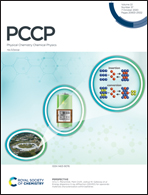Acetylation of graphite oxide†
Abstract
Unlike many methods of chemical modification of Graphite Oxide (GO) reported during 1930–1960 and re-studied in much detail over the last decade, acetylation somehow escaped attention and remained almost completely unexplored. Acetylated Graphite Oxide (AcGO) was prepared using a reaction with acetic anhydride. Successful acetylation is evidenced by an increase in the average interlayer distance from d(001) = 7.8 Å in the precursor GO to 10 Å in AcGO. The amount of oxygen in AcGO significantly decreased compared to the precursor GO (C/O = 2.2), reflecting partial reduction of GO in the process of acetylation and resulting in a scarcely functionalized material with C/O = 6.2. A theoretical model of the complete acetylation of GO results in a non-porous close packed molecular structure with an interlayer distance of ∼10 Å, in good agreement with experiment. Remarkably, AcGO shows significant swelling despite the oxidation degree being comparable to that of reduced GO, which does not swell in polar solvents. Moreover, AcGO shows swelling in acetonitrile similar to that of the precursor GO but not in water, thus providing an example of selectivity in the sorption of common polar solvents. The low oxidation degree combined with selective swelling properties makes AcGO a promising material for membrane applications.

- This article is part of the themed collection: 2020 PCCP HOT Articles


 Please wait while we load your content...
Please wait while we load your content...